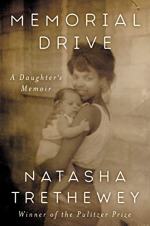|
This section contains 809 words (approx. 3 pages at 400 words per page) |

|
Memorial Drive Summary & Study Guide Description
Memorial Drive Summary & Study Guide includes comprehensive information and analysis to help you understand the book. This study guide contains the following sections:
This detailed literature summary also contains Topics for Discussion on Memorial Drive by Natasha Trethewey.
The following version of this book was used to create this study guide: Tretheway, Natasha. Memorial Drive. New York: Ecco/HarperCollins, 2020.
Memorial Drive opens with Natasha Trethewey recounting a recurring dream she has about her mother, Gwendolyn Turnbough, who was murdered by her ex-husband, Joel Grimmette, in 1985. In the dream, Trethewey walks with her mother around a path. They are confronted by Joel, whom Trethewey greets. A moment later, Joel reappears with a gun and shoots Gwendolyn.
In the prologue, Trethewey describes the last photograph taken of her mother before she died. She recalls driving to Gwendolyn's apartment the day after the murder to go through her things. She later saw herself on the news, arriving outside of the building. She felt a sense of separation from herself.
Trethewey's childhood began in North Gulfport, Mississippi in the late 1960s, where she grew up doted on by her mother's extended family but also aware of the racism of the time and place. Gwendolyn was Black and her father, Eric, was white. They were often subjected to abuse and animosity by racists who had a problem with interracial relationships. When Trethewey was a baby, the Ku Klux Klan burned a cross on her grandmother's lawn because she often had white visitors staying in her home. The author also recalls a traumatic experience in which she nearly drowned on a vacation with her parents in Mexico. She remembers seeing her mother's face above the surface of the water, ringed in a halo of light.
When the author was six years old, her parents divorced and she moved with her mother to Atlanta. She was upset about the move, and when Gwendolyn's car broke down on the drive to their new home, Trethewey believed she had somehow caused this to occur. Within a year of arriving in Atlanta, Gwendolyn met Joel. While they were dating, Gwendolyn often left Joel to babysit the author, and when she upset him in some way, he would drive her in a loop around the city threatening to leave her somewhere alone. Trethewey never told her mother about this.
In 1973, Gwendolyn picked Trethewey up from Mississippi where she had spent the summer and told her that she and Joel had married and that she had a new baby brother. Trethewey believed her little brother Joey was Joel's child from a previous marriage until she saw his birth certificate many years later and discovered he was her mother's son.
Trethewey heard Joel hitting her mother for the first time when she was in fifth grade. She told her teacher, but the teacher dismissed her concerns, telling her, “sometimes adults get angry with each other” (103). When she was 12, Gwendolyn gave her a diary to write in, but Trethewey soon discovered Joel had broken its lock and read what she had written. She began writing notes in it directly to him—angry missives about how much she hated him.
At the beginning of Part II, Trethewey recalls visiting a psychic in 2014, just as her mother did in the days leading up to her murder. Trethewey did not believe in clairvoyance, but she still felt disappointed when the psychic gave no indication he could contact her mother during the reading. However, when she later played back the recording she had made of the session, she realized he had repeatedly mentioned numbers that corresponded with her death date.
Trethewey includes a letter written to police by Gwendolyn in which she describes Joel's abusive behavior and how she finally left him in 1983. Trethewey recalls how, a week after they left, Joel came to a high school football game looking for her. When she saw him, she greeted him. She later learned he had come to the game to shoot her but decided not to after she spoke to him.
In February 1984, Joel tried to kill Gwendolyn. Trethewey provides the police report detailing their encounter, after which Joel served a year in prison. When he was released, he immediately began harassing Gwendolyn again. The author provides transcripts of phone conversations they had on June 3-4, 1985 in which Joel repeatedly threatened to kill her if she would not enter into a romantic relationship with him again. On June 5, 1985, he came to her apartment in the morning and shot her.
Trethewey was 19 years old at the time of the murder. A police officer came to her dorm room at the University of Georgia to inform her and drove her to the police station, where she met her grandmother and her father.
In the memoir's final chapter, Trethewey recalls once more her recurring dream and her experience of nearly drowning in Mexico. She contemplates the way trauma affects a person on a deep level and how the guilt and grief she felt surrounding her mother's death have transformed her and made her who she is today.
Read more from the Study Guide
|
This section contains 809 words (approx. 3 pages at 400 words per page) |

|



